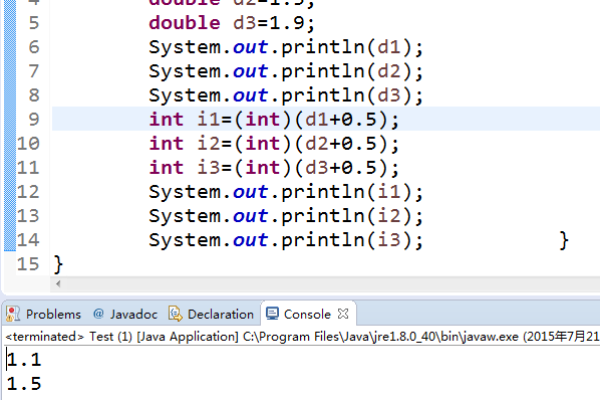如何在Java中实现四舍五入操作?
- 行业动态
- 2024-11-11
- 1
在Java中,可以使用 Math.round()方法来进行四舍五入操作。
Java中的四舍五入

在Java编程中,四舍五入是一个常见的操作,通常用于处理浮点数的精度问题,本文将详细介绍Java中实现四舍五入的方法,包括使用Math.round(),BigDecimal类,以及其他自定义方法。
1. 使用Math.round()
Math.round()是Java标准库中最常用的四舍五入方法,它有两个重载版本,一个用于处理float类型,另一个用于处理double类型。
1.1 Math.round(float a)
这个方法将float类型的数字四舍五入为最接近的整数,如果小数部分 >= 0.5,则向上取整;否则向下取整。
public class RoundExample {
public static void main(String[] args) {
float num = 3.6f;
long roundedNum = Math.round(num);
System.out.println("Rounded number: " + roundedNum); // 输出:Rounded number: 4
}
}1.2 Math.round(double a)
这个方法与Math.round(float a)类似,只是参数和返回值类型不同。
public class RoundExample {
public static void main(String[] args) {
double num = 3.6;
long roundedNum = Math.round(num);
System.out.println("Rounded number: " + roundedNum); // 输出:Rounded number: 4
}
}2. 使用BigDecimal
BigDecimal类提供了更精确的控制,可以指定四舍五入的模式和小数位数。
1 BigDecimal的基本用法
import java.math.BigDecimal;
import java.math.RoundingMode;
public class BigDecimalExample {
public static void main(String[] args) {
BigDecimal num = new BigDecimal("3.6");
BigDecimal roundedNum = num.setScale(0, RoundingMode.HALF_UP);
System.out.println("Rounded number: " + roundedNum); // 输出:Rounded number: 4
}
}2 不同的舍入模式
BigDecimal支持多种舍入模式,如RoundingMode.DOWN(向下舍入),RoundingMode.UP(向上舍入),RoundingMode.CEILING(向正无穷方向舍入),RoundingMode.FLOOR(向负无穷方向舍入)等。
import java.math.BigDecimal;
import java.math.RoundingMode;
public class BigDecimalRoundingModes {
public static void main(String[] args) {
BigDecimal num = new BigDecimal("3.6");
BigDecimal down = num.setScale(0, RoundingMode.DOWN);
System.out.println("Down: " + down); // 输出:Down: 3
BigDecimal up = num.setScale(0, RoundingMode.UP);
System.out.println("Up: " + up); // 输出:Up: 4
BigDecimal ceiling = num.setScale(0, RoundingMode.CEILING);
System.out.println("Ceiling: " + ceiling); // 输出:Ceiling: 4
BigDecimal floor = num.setScale(0, RoundingMode.FLOOR);
System.out.println("Floor: " + floor); // 输出:Floor: 3
}
}3. 自定义四舍五入方法
除了使用Java标准库提供的方法,我们还可以编写自定义的四舍五入方法,以满足特定需求。
1 自定义四舍五入方法示例
public class CustomRound {
public static int customRound(double value) {
return (int) (value + 0.5);
}
public static void main(String[] args) {
double num = 3.6;
int roundedNum = customRound(num);
System.out.println("Custom Rounded number: " + roundedNum); // 输出:Custom Rounded number: 4
}
}4. 表格比较不同方法的效果
下表展示了不同四舍五入方法的效果对比:
| 方法 | 输入 | 输出 |
| Math.round | 3.6 | 4 |
| BigDecimal (HALF_UP) | 3.6 | 4 |
| BigDecimal (DOWN) | 3.6 | 3 |
| BigDecimal (UP) | 3.6 | 4 |
| BigDecimal (CEILING) | 3.6 | 4 |
| BigDecimal (FLOOR) | 3.6 | 3 |
| 自定义方法 | 3.6 | 4 |
相关问答FAQs
何时使用Math.round()?
Math.round()适用于简单的四舍五入操作,特别是当精度要求不高时,它是标准库方法,使用方便且性能较好。
何时使用BigDecimal?
BigDecimal适用于需要高精度计算的场景,例如金融计算,它允许指定舍入模式和小数位数,提供了更高的灵活性和控制力。
各位小伙伴们,我刚刚为大家分享了有关“java四舍五入”的知识,希望对你们有所帮助。如果您还有其他相关问题需要解决,欢迎随时提出哦!
本站发布或转载的文章及图片均来自网络,其原创性以及文中表达的观点和判断不代表本站,有问题联系侵删!
本文链接:http://www.xixizhuji.com/fuzhu/103322.html



